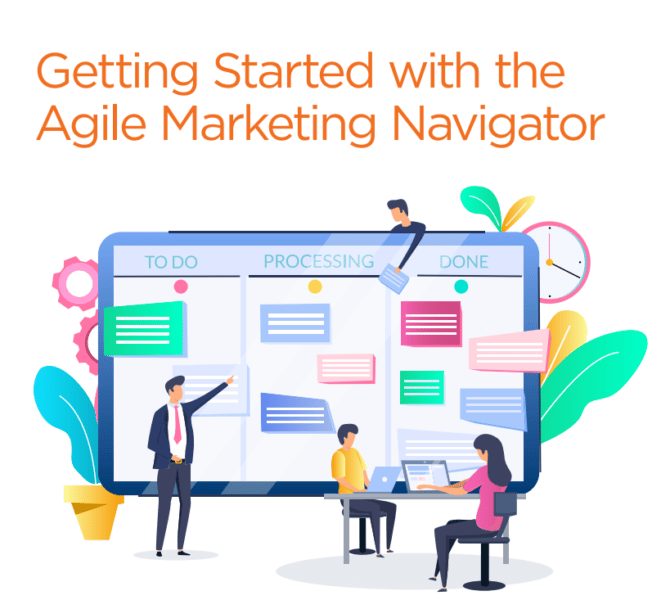I recently had an epiphany about agile marketing. We’re 10 years behind our software counterparts!
That may not be surprising, as agile marketing started about 10 years after it did in software development, but why are we still so far behind? What are the barriers that are getting in our way and how can we remove them?
In this article, I’m going to share with you three reasons why I think marketers are behind with agile implementations and what we can do to catch up.
1. Language Barriers
A few years ago I had an amazing opportunity to teach an agile class in Haifa, Israel. While I’d taught the content many times before, what I didn’t take into consideration was the language barrier. I’m sure I made a lot of American references that they didn’t understand, and when they went to do team activities, they all spoke in Hebrew, making it incredibly difficult for me to validate if the learning was registering. So while the learning can and does happen, the time to get there will expand in those kinds of circumstances.
But barriers can also be created by aspects of a common language — for example, acronyms.
When you see the term “PM” what do you think of? Depending on your perspective, this could be a project manager, program manager, product manager or even preventative maintenance — not to mention just “afternoon.” It’s really confusing.
When marketers are forced into translating terms from a language that was written with product and software development in mind, problems can arise because the language doesn’t speak to them.
2. Framework resistance
When I began moving my agile coaching practice into the marketing space, I quickly realized that I was trying to teach Scrum the same way that I did in software development. It wasn’t working. I was met with a ton of resistance.
Here were some common objections I heard:
- “Scrum is a process for IT.”
- “Scrum doesn’t make sense in marketing.”
- “The language in Scrum is for software developers.”
- “We don’t want a rigid process.”
I kept thinking about this resistance. The problem I concluded wasn’t in the framework. The problem was getting acceptance of the framework outside of the software world.
3. Reinventing the wheel
As an industry, more than 60% of agile marketers are implementing a hybrid or scrumban (Scrum/Kanban combination) approach, according to the 2022 State of Agile Marketing survey.
While inventing a hybrid approach seems like a great way to take what’s out there and customize it to marketers’ needs, the biggest challenge was that there was no consistent way that this was happening. Going from company to company, I saw a lot of marketers trying to reinvent the wheel, which meant it took them a lot longer to get off the ground while software teams were already flying.
However, if we look back at our agile history, software development had a similar beginning. There were dozens of methodologies that are no longer talked about today such as the Crystal, XTreme Programming, Adaptive Software Development and many more.
It wasn’t until Scrum became the gold standard in software development that real change began to happen. I believe it’s because, when everyone agrees on a common method and language, we have a mutual starting point. We don’t have to start at square one. We can just learn from there, all agree on the path and work on what’s really important — lasting cultural change.
Get MarTech! Daily. Free. In your inbox.
Getting ahead!
Now that you know my theory on why agile in marketing is 10 years behind, how can we break the cycle and move forward? Here are 5 things to try:
- Avoid technical jargon or terms that people don’t understand.
- Don’t try to sell teams or leaders on a process, but rather what you’re going to do to resolve their business problems.
- Allow flexibility around agile practices and choice. By allowing teams to choose from a few options that meet their needs, they’ll be more accepting.
- Provide a clear roadmap for teams on how they’ll go from point A to point B.
- Clearly outline what success looks like for each team and steps for getting them there.
For more ways on how we’ve bridged the gap between software teams and marketing teams with agile, read our latest eBook on how to get started with the Agile Marketing Navigator.

Opinions expressed in this article are those of the guest author and not necessarily MarTech. Staff authors are listed here.



























































![LinkedIn Provides Tips on How to Promote Live Events [Infographic] LinkedIn Provides Tips on How to Promote Live Events [Infographic]](https://imgproxy.divecdn.com/kA4YczoBIs8NmPBiERWa-OxzvYMz5kwjjZ6wewP8z7c/g:ce/rs:fit:770:435/Z3M6Ly9kaXZlc2l0ZS1zdG9yYWdlL2RpdmVpbWFnZS9saW5rZWRpbl9ldmVudF9hZHNfaW5mb18yLnBuZw==.webp)










